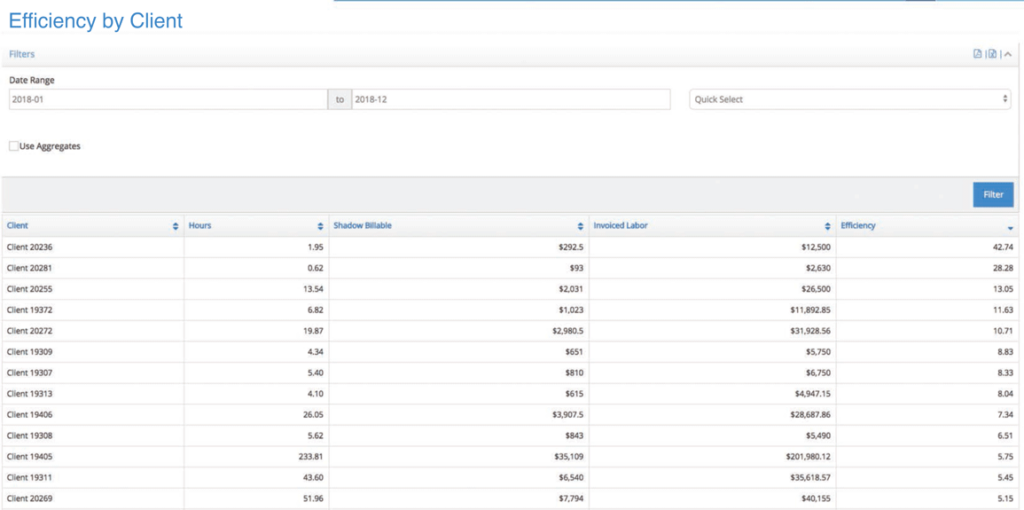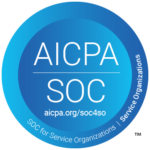For any MSP, data should drive strategy. It’s not just what the data shows you, but how you use that data, that determines business success. In this blog we will focus on the pricing aspect of MSP business strategy. How you can use data to determine what your pricing should be.
First, we’ll look at two ends of the client spectrum: clients to whom your MSP is dedicating more hours than you’re getting paid for, and clients whose relationship with your MSP is so efficient that they pose a flight risk. Then we’ll look at how to use efficiency ratios to determine if pricing is too low or too high. Understanding efficiency lets you take action to address both ends of the spectrum, so your clients will all fall within the healthy range.
Use Reports to Determine Whether Your Pricing Is On Track
At MSPCFO, we use the metric of “efficiency,” a somewhat more robust tool than effective hourly rate. Efficiency, unlike effective hourly rate, takes into consideration that the value of an hour of work could be different (level 3 vs. level 1 or after hours vs. regular, etc). While effective hourly rate assumes every hour is the same. In short, efficiency is what you get paid versus the value of what you do.
effective hourly rate=how much you effectively get paid per hour for the work you do
efficiency ratio=invoiced labor / value of labor (hours x billable rate) covered by an agreement
For instance, if an engineer puts in 4 hours at $150/hour, that’s $600 of shadow billable. If the invoiced labor is $500, the efficiency is 0.83. (Invoiced labor is the labor portion of your monthly recurring revenue. That is what your MSP is getting paid to do the work, taking away the agents, tools, etc.) MSPCFO provides efficiency ratios in a table, with the option to sort by efficiency.
Many industry pundits recommend agreement efficiency between 0.8 and 1.5. When the efficiency ratio is below 0.8, you’re getting paid too little for what you’re doing. If it is above 1.5, you’re not doing enough work for the client, and that client could be a flight risk.
With MSPCFO reports, you can look at efficiency by client, by agreement or by a custom range of clients.

Use Efficiency to Determine Whether Pricing Should Change
Review client efficiency with account management and operations, and focus on improving efficiency one by one for each client, rather than trying to fix the whole business. Low-efficiency clients may require a price increase, or high-efficiency clients may need a price reduction. Another solution might include changing personnel for a client. With individual attention to each under- or over-performing client, you can potentially increase profits substantially. But you have to get there by first having strong data that will let you identify problems right away.
This does not mean that there is not also value in effective hourly rate. Effective hourly rate provides a straightforward view into how many hours are delivered as compared to expectations. When an MSP is servicing a client for more hours than was expected at the time of the agreement, either the MSP is being paid too little, or its engineers are doing too much work. Target hours for a given client are equal to revenue divided by your target effective hourly rate. If your target hours are less than your actual hours, you’re not generating the revenue you anticipated.
target hours = labor revenue / target effective hourly rate
For instance, if you have a $3,000/month client, if you want to have an effective hourly rate of $150/hours then you will want to deliver 20 hours for that client. But if you end up delivering 30, then you are delivering 10 hours more than your goal. Since time is your cost, this client is now costing more than expected.
You can drill down into the FFA Monthly Tracking report in MSPCFO on a client basis and identify which are the problem customers. The FFA tracking report shows you total FFA hours, total target hours, and total delta hours. Positive delta hours are good; negative ones are less so. For every partner we work with, there are clients that are on both ends of the spectrum. This is where you want to focus management efforts on improvement. It is important to note that partners whose client base has a good average effective hourly rate will still have problems. Too often partners start focusing on the averages rather than the specific partners that are causing the problems. Put another way, if you fix the problems in your most underperforming client your averages will improve. It is also the best way to get a good return on your investment.
To address the issue of underpayment or overwork, consider increasing your invoices rate with the client. Show the client the numbers, and explain that they’re not where they need to be, but you want to make the relationship work. Indicate exactly what the rate would need to be in order to make that happen. MSPCFO was designed to provide completely transparent reporting. Why not extend that transparency to the MSP-client relationship?
Pricing for Clients Generating Too Few Hours
There is such a thing as too much efficiency with a client. Clients become a flight risk when they feel they are being underserved. They may feel as though they’re not getting their money’s worth, and they may start to look into alternate MSP services.
If, in the $3,000/month client scenario above, only 10 hours are being delivered, the client is not getting the most out of the FFA. One solution is to offer a discount. Again, show the client the reports, and show that the hours anticipated are more than the hours delivered. You want to establish a long-term relationship. Clients will appreciate your team’s capabilities, efficiency, and transparency. Greater client satisfaction results in greater stability.
Here’s one final equation to end this post on
strategy + data = solution
- Which clients are your worst performers and which are the best (and which are at risk of leaving)
- Where you might want to consider proposing a project to a client
- Which engineers are the most productive relative to their compensation
- Where gaps exist in your data (every MSP has them)
There is no obligation for this and you will gain valuable, actionable insight into your MSP. Please schedule your time here.
Want to Improve Your Bottom Line?
Schedule Your Personalized Demo





